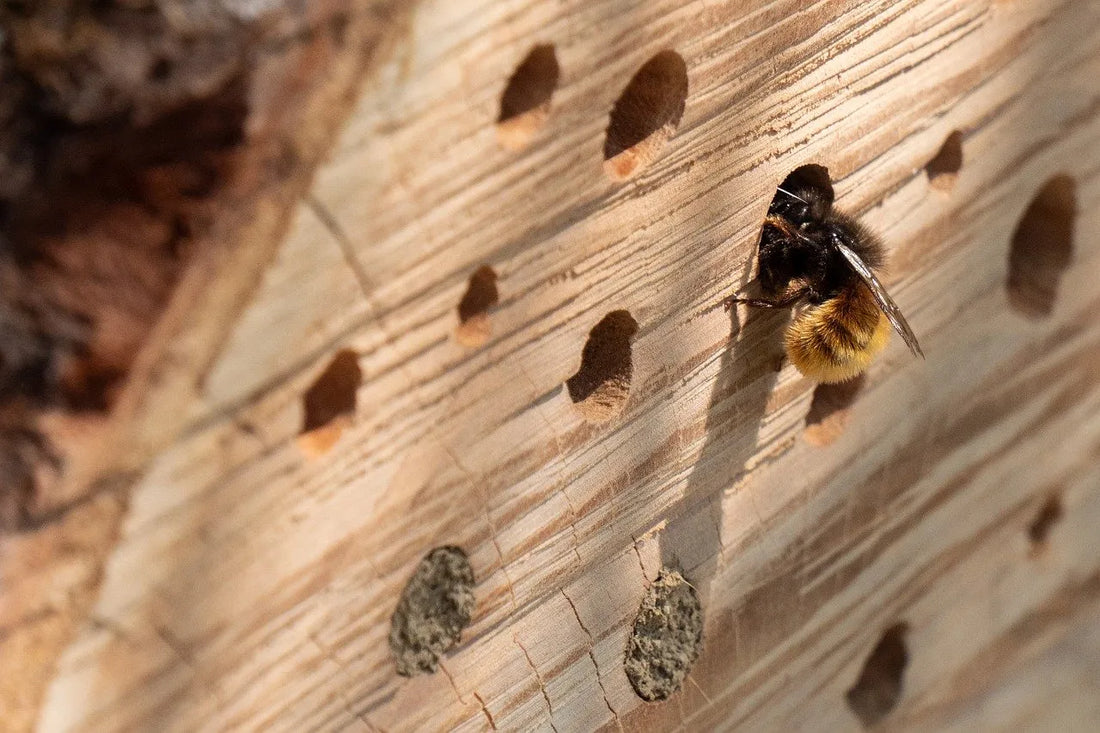How does a bee hotel work is one of the most frequently asked questions we have received since launching our bee hotel. So, we felt it would be beneficial to share here on our blog alongside some other important questions we have answered!
As you may know our precious pollinators are facing a crisis having lost much of their natural habitat due to urban development, change of land use and intensive farming.
Bee hotels are a great way to help our solitary bees, by providing much-needed shelter in our gardens - unlike bumblebees and honey bees, who live in colonies. According to Friends of the Earth's guide a variety of bee species could take up residence in your bee hotel, they are most likely to be: red mason bees, blue mason bees, leaf cutter bees and white faced bees.
The 3 most commonly asked questions about bee hotels;
1) Where do I place my bee hotel?
The bee hotel should be positioned in a sunny area, south or south-east facing and hung securely from a wall or fence using a nail or screw. It is important not to let the bee hotel swing or sway in the wind as bees are terrible at landing! Heat from the sun will help warm bees in the morning and this will also help prevent the components from going mouldy. Locate your bee hotel at least one metre above ground level, ensuring no vegetation is blocking the tunnels.
Plant bee-friendly flowers underneath your hotel to give them a nearby food source. We suggest planting a variety of flowers and plants which will provide pollen and nectar throughout the year.
Be patient: Bee's may not take up residence in your first year. You'll know when they arrive because the entrance of the tunnels will be blocked off with mud or leaves! By late July your bee hotel may be full of eggs and food.
 Leaf cutter bee by Jon Hawkins, Surrey Hill Photography
Leaf cutter bee by Jon Hawkins, Surrey Hill Photography
2) When to put a bee hotel out?
Most designs are temporary so in the winter months, between October and February we recommend carefully moving your bee hotel into a garden shed or outer building. Somewhere dry and cool for protection from the elements. The rain is their adversary and they need to be protected from the persistent heavy rain in the winter - rather than the cold.
Place the hotel outside again in March ready for Spring. This is when your new guests will want to 'check-into' your hotel for the summer. You will know when they start to nest as they will return with pollen attached to their hind legs and materials like mud and leaves to create walls within the tube.
3) How do I clean my bee hotel?
Maintenance of your bee hotel is crucial. Please do not install your bee hotel and forget about it! It is essential for the health of the bees who reside there, but it will also extend the life of the bee hotel itself. In a natural environment the tunnels would not be so close together therefore pests and mould may spread more easily.
Keep an eye out for any guests who are not welcome like the fly Cacoxenus indigator (below) whose larvae eat the stored pollen and bee larvae.
 Cacoxenus indigator
Cacoxenus indigator
At the end of the summer identify any cells that are still walled where no young bees have emerged. These need to be removed and cleaned with a pipe-cleaner, a small brush or by blowing compressed air inside.
Every two years the tunnels will need to be replaced with fresh new ones. This will help prevent the build up of fungus, mould and parasites and give your hotel a little spruce!
During the winter months, let your garden grow wild.
Whilst your hotel is away for the winter you can help bees and other pollinators by leaving your garden 'messy'. By dedicating a spot that is un-trimmed and layered with leaves this can become a habitat for bees to survive and reproduce. It's a super easy way to make a difference and create a buzz in your garden.
Use your bee hotel as an awesome conversation starter to talk about the importance of bees with your friends. If you would like to gift a bee-loving friend then why not treat them to a ready-made bee hotel? For every product sold we will also plant one tree in our efforts to re-build habitats that have been lost.
We hope this has helped you! If you have any further questions please reach out as we'd love to hear from you.



 Beevive Bee Hotel 2.0
Beevive Bee Hotel 2.0 Solitary Bee Bamboo Tubes
Solitary Bee Bamboo Tubes